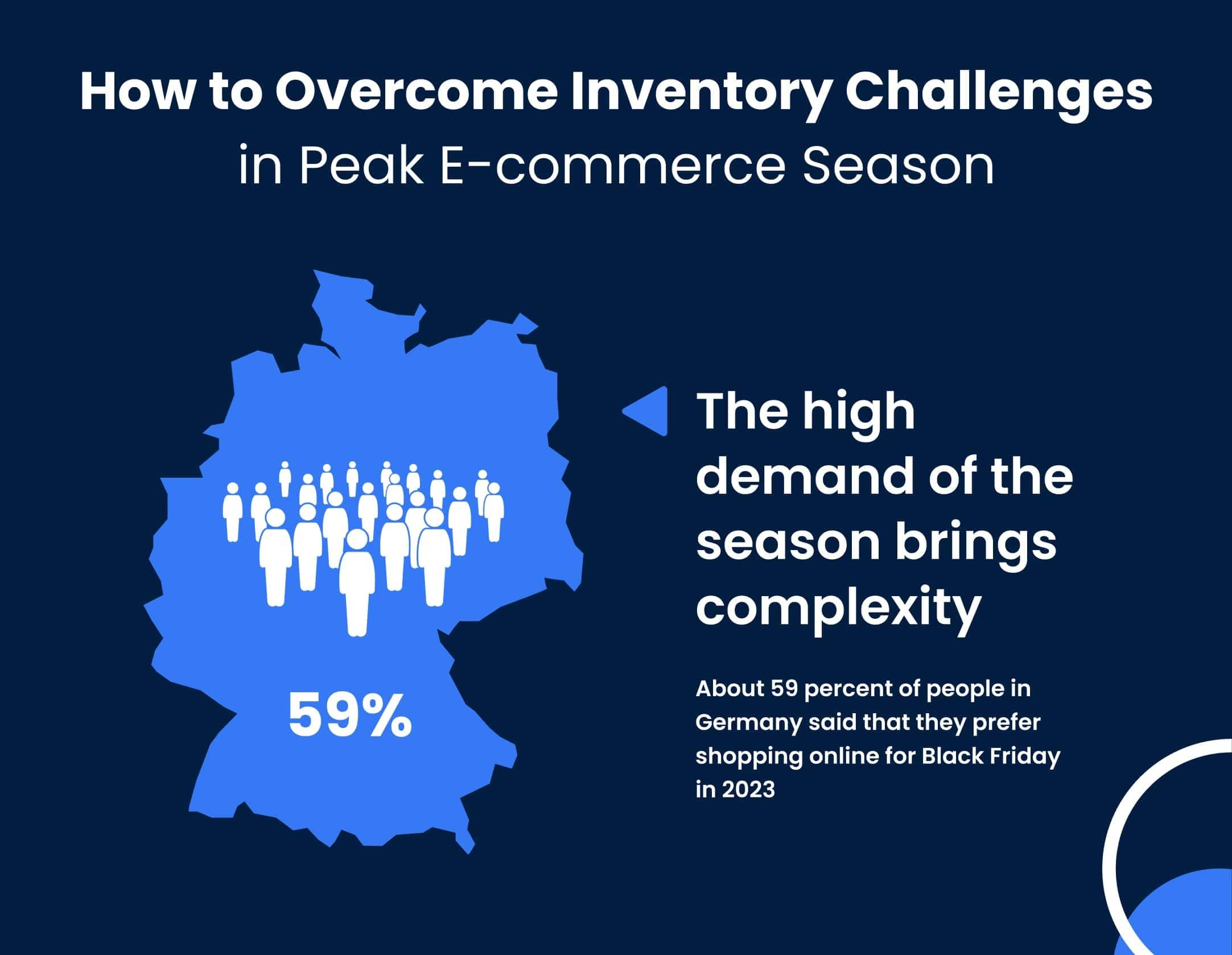How to overcome inventory challenges in peak e-commerce season
Written by
Editorial TeamPublished on
Navigating the peak e-commerce season can be daunting, with challenges like stockouts, overstocking, and supply chain disruptions threatening your success. This guide, featuring Fabrikatör, offers practical strategies to overcome these hurdles by automating inventory management and leveraging accurate demand forecasting. (Ad)

Commercial collaboration
A lot can go wrong during the peak season for e-commerce brands. It’s a make- or-break moment for most businesses. Dealing with the supply chain effectively is crucial during this time, especially considering that 55% of e-commerce brands in Germany were affected by supply chain disruptions, according to Statista.
Stockouts, overstocking, delayed deliveries, and supply chain disruptions are their most common hurdles during peak times in the market. Do any of these sound familiar to you? Well, you’re not alone.
The good news is that many inventory-related challenges can be prevented with proper planning and building safety nets. You can get your inventory ready to meet the demands of the high e-commerce season. How? Let’s dive in!
The Most Common Inventory Planning Challenges of eCommerce Stores During Peak Seasons
If your inventory plans for the peak season don’t align with what actually happens, your inventory planning methods and tools might need to be revised.
The inefficiency of the inventory process of an e-commerce store during the peak season looks like:
- Extra charges from rushing last-minute orders and expedited shipping,
- Overstocking leading higher storage costs,
- Running out-of-stock and missing sales,
- Orders not arriving on time and having strained relationships with suppliers and customers,
and many more. That’s when you start to think, what causes this scene?
Identifying the reasons behind these inefficiencies is important to overcome them.

Handling inventory on spreadsheets? Not the best idea!
Close to 90% of spreadsheets contain errors, often due to human errors. This results in poor data quality, which can be disastrous, especially during peak seasons. As stores expand their product variety and SKU numbers, the manual workload increases significantly, making it nearly impossible to manage
accurately. Consequently, spreadsheets and other manual methods are not only error-prone but also time-consuming.
Updating inventory status, checking stock levels, and planning based on this data becomes increasingly challenging. During high-sales peak seasons, the intense workload makes accurate tracking and data entry even more difficult.

Lack of visibility + Error-prone data + Time Consuming = Nightmare for Merchants
Additionally, spreadsheets lack visibility, making it hard to take immediate action. For example, if a new trending item requires restocking sooner than expected, manual processes might delay your response, leading to missed sales opportunities.
Manual inventory methods’ poor data accuracy prevents reliable inventory planning that matches real demand during peak seasons. This imbalance between forecasted and actual demand can lead to stockouts or overstocking, resulting in missed sales opportunities and increased costs. Furthermore, human errors in manipulating data and dealing with formulas can lead to incorrect orders, compounding these issues.
Don’t let Black Friday become your weakest point
During peak seasons, merchants cannot afford the mistakes that might stem from manual efforts. Therefore, finding an inventory management solution that fits their needs before the season arrives is crucial for success. This will ensure accurate inventory tracking, optimize operations, and better meet customer expectations.
On the contrary to managing inventory manually, automated processes provide accurate, up-to-date insights with various data analytics reports, enabling the best replenishment and planning decisions for your business. Plus, the time saved from not managing inventory manually can be redirected to marketing and other growth activities, which is crucial for scaling the business.
German companies are increasingly adopting software for better inventory control
German companies also realize this fact. The 2024 Statista report highlights that companies in Germany are increasingly adopting software to optimize their supply chain operations due to the growing complexity of supply chain networks and the need for real-time visibility and control over inventory.
Inventory management solutions diminish the complexities that e-commerce stores face. Inventory planning software designed for e-commerce stores, Fabrikatör, can help merchants plan the high season with confidence and speed up replenishment and purchase order processes. Plus, they offer a reliable data source and up-to-date insights, allowing you to make the best replenishment and planning decisions for your inventory.
Swinging back and forth between overstock and stockouts
Becoming overstock and stockout might be the story of most merchants. While overstocks increase costs incredibly due to the holding costs, stockouts lead to a loss of revenue. These two problems are draining merchants’ cash flow.
Even though the heart of this problem might lie in managing inventory on Excel or manually, especially during peak seasons like Black Friday and Christmas, managing inventory and planning demand is essential, and stockouts are a problem that you don’t want to deal with.
Effective inventory management makes operations run smoothly, and merchants can meet customer expectations.
Because a well-rounded inventory management system can:
- Minimize stockouts and overstocks
- Reduce costs
- Improve resource allocation
- Increase supply chain responsiveness.

The high demand of the season brings complexity
For e-commerce stores, inventory planning during peak sales times can be extra tricky because unexpected demand surges are more likely.
About 59 percent of people in Germany said that they prefer shopping online for Black Friday in 2023. As the demand is this high, not having real-time and accurate data about inventory levels and locations can make your inventory operations more complex.
Due to the lack of advanced features your business requires, your store may end up with stock imbalances: running out of popular items that customers eagerly await or having too many items that aren’t selling well.
This imbalance not only increases your storage costs but also damages your fulfillment processes. Delays in shipping and incorrect stock levels can lead to unhappy customers and missed sales opportunities. To make it through these peak times smoothly, having efficient inventory management is crucial to keep everything running smoothly.
Surprise effect: unpredictable demand for new items
Whether you’re realizing a new collection of items for BFCM or some of the products become more popular than expected, if you don’t have enough stock to meet customer demand, it’s an invitation to disaster, resulting in missed opportunities and lost sales.
First, accurately forecasting demand, and second, getting your inventory prepared for different scenarios are necessary to stay proactive in times of demand surges. As your e-commerce store grows, just basing your inventory planning on sales data from previous years is not going to solve this problem because:
- The numbers and variety of products don’t remain the same for a growing e- commerce store, and as these increase, demand planning becomes more complicated.
- Customer tastes and trends evolve quickly, so past data might not reflect current market demands.
- Each peak season can have unique factors influencing sales, such as economic conditions or competing promotions, which aren’t captured in past data.
Therefore, when using historical data for forecasting, you must first ensure its accuracy. This can be achieved if you use software capable of robust data analysis. Additionally, it is important to consider and evaluate environmental factors, changes in your target customers, and current trends alongside the data.
Preorders for market trends; backorders as a safety net
Preorders are also a great way to understand your customer’s preferences for a new collection. WRISTR, previously known as Apfelband, successfully applies this strategy as market research to see the possible trending items in new seasons.
This information allows you to reduce the purchasing time and improve inventory management. Additionally, preorders can help increase customer engagement and loyalty, as they feel more involved in the product launch process.
On the other side of the coin, if you have run out of stock with your popular items during high-sales periods like Christmas, Black Friday, and Valentine’s Day, backorders will provide you with a safety net. While customers can still buy products with discounted price tags, it will allow your store to prevent revenue loss and cover your cash flow while new items are being shipped.
The essential part of successfully applying preorders and backorders lies in finding an inventory solution that integrates with your communication tool like Klaviyo because transparent customer communication will not only increase customer satisfaction but also build brand trust.
Bridging the gap between marketing and inventory
Black Friday and Cyber Monday (BFCM) are critical periods that marketing teams must prepare meticulously. They pour all their efforts into crafting marketing campaigns, running ads, planning influencer marketing, and more, all to attract and convert the heightened demand during BFCM. However, if the inventory plan isn’t executed well, stockouts become inevitable. This not only leads to missed sales opportunities but also forces marketing efforts to come to a halt, creating significant pressure on the teams.
To prevent this, integrating inventory planning with the marketing calendar is crucial. During peak periods like BFCM, regular restocking isn’t enough. Effective planning for the next few purchase orders (POs) is essential. It enables merchants to plan for the upcoming months by applying growth rates and using similar items as benchmarks for new collections.
In addition to demand planning, implementing a robust inventory planning system can help overcome these challenges by providing real-time inventory tracking and facilitating seamless communication between marketing and inventory teams. This setup ensures your business is prepared for success, especially during peak seasons when demand surges.
Implementing an inventory management solution early on
Peak seasons, in particular, require quicker responses to customer demand and faster decision-making. Especially for growing e-commerce stores, as their business expands, they face increasingly complex inventory data that becomes more challenging to manage. Therefore, these stores need speed, accurate
decision-making, and efficiency in managing their inventory and running their stores. To address this, implementing a reliable inventory management solution supports your growth, speeds up your processes, and simplifies decision-making.
Demand forecasting and on-time replenishment help growing e-commerce businesses have the right products available at the right time to meet customer demand. In addition, businesses can save a lot of time with quick purchase order generation, evaluate their inventory deeper with real-time inventory data and reporting tools, and manage out-of-stock in a more profitable way with backorder management capabilities to sustain their success.
Overall, managing your processes becomes easier, and you can proactively oversee your entire inventory process. Imagine having a bird’s-eye view of your inventory management, where you see only the most critical details and are confident in their accuracy—that’s what good inventory management software like
Fabrikatör does for you. Moreover, with effective planning, you can use this overview to shape your future inventory plans when the peak season is coming.

About Fabrikatör:
Fabrikatör, based in the heart of Berlin, is an inventory planning solution tailored for e-commerce stores. It empowers brands to optimize their inventory operations through efficient replenishment and accurate forecasting.
***


